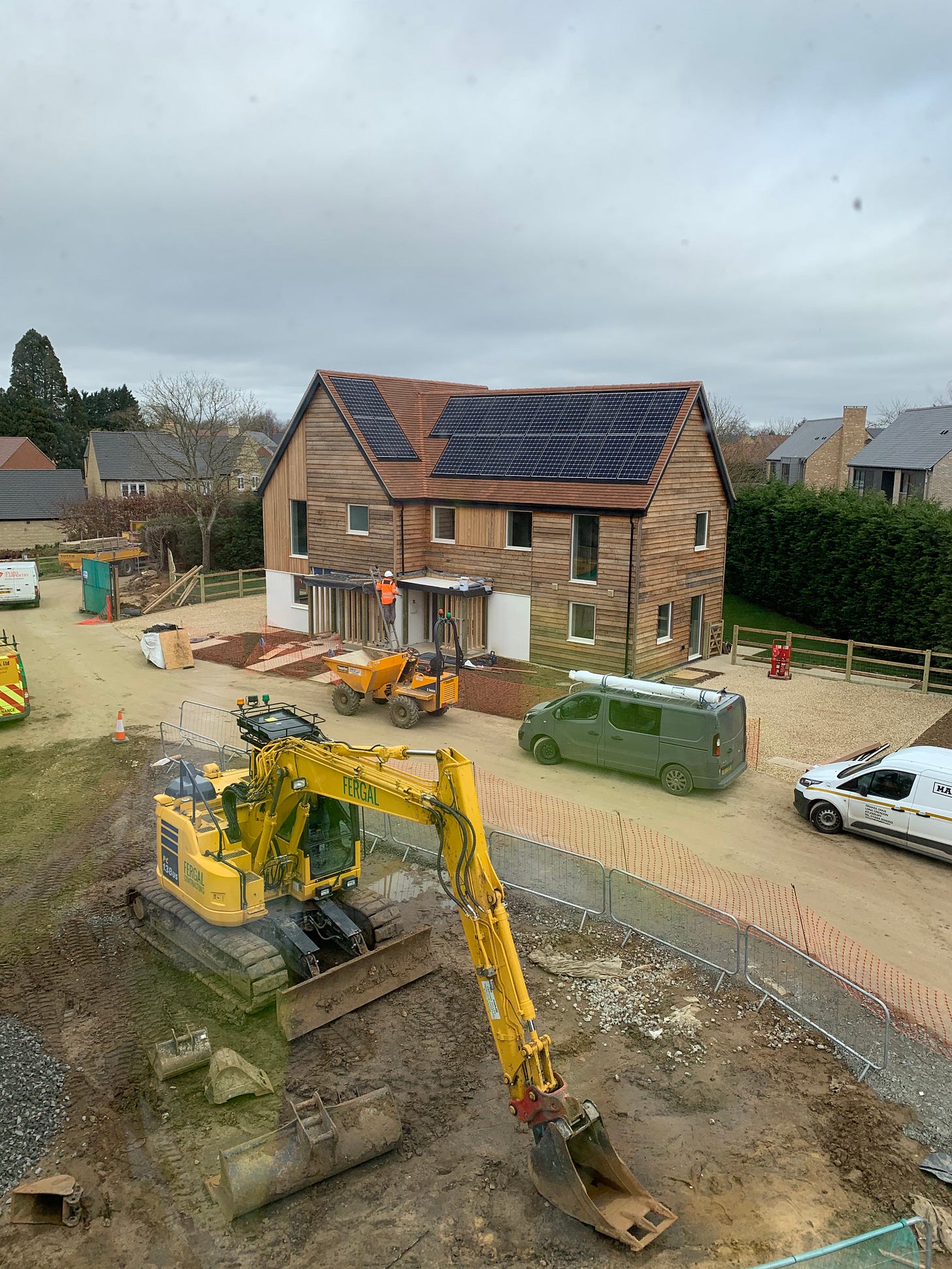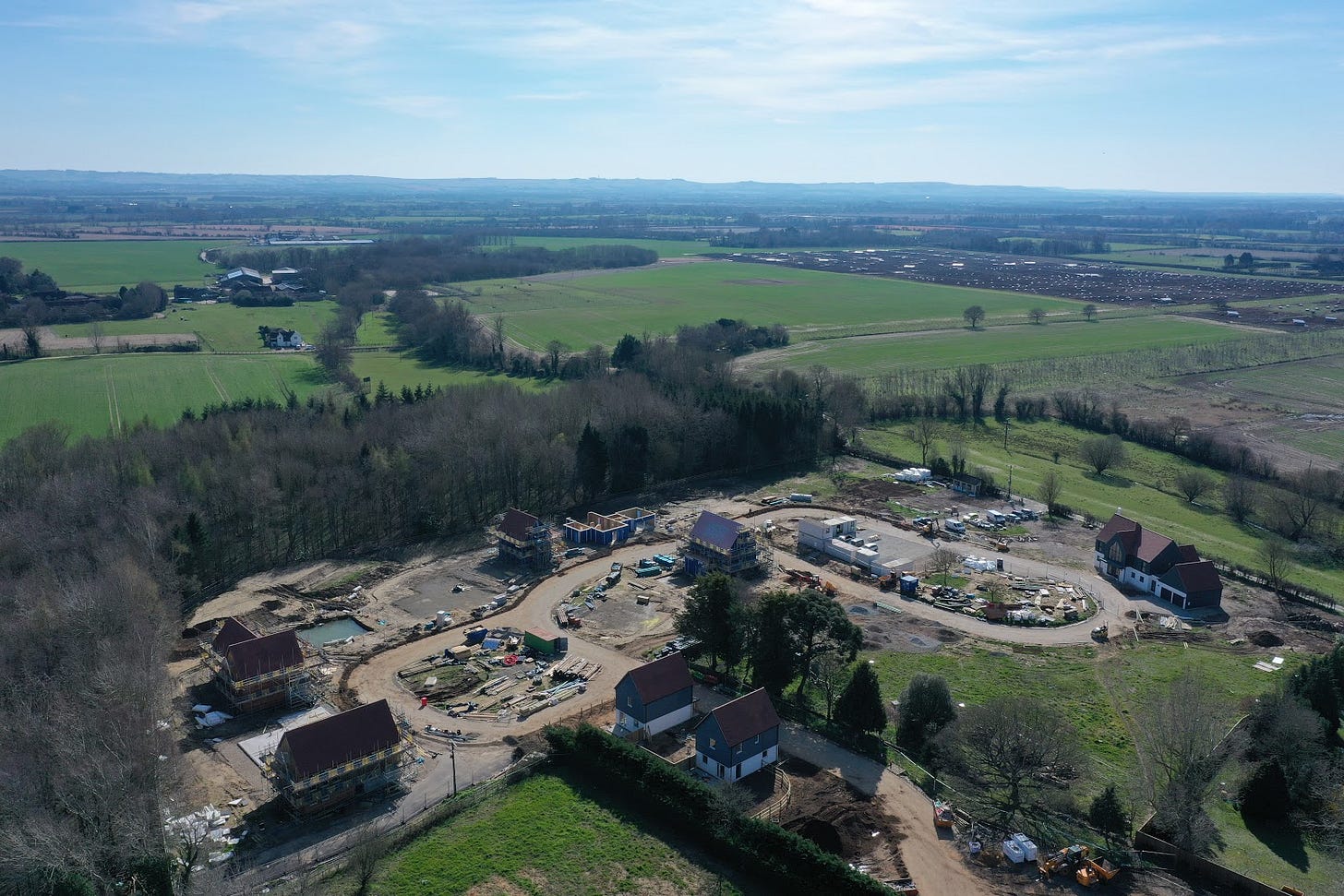Simple climate action at home // I S S U E # 3 2 // H E A T I N G
Home is where the emissions are
By Michael Coren
Each year, sector by sector, the world is decarbonizing. Electricity has gone first. Astonishingly cheap wind and solar power (the latter is down 99% since 2000) have slashed emissions in the power sector. In the UK, they’re back to where they were in 1890. Transportation has gone next. Advanced batteries have made electric cars, trucks, trains, ships, and even aircraft commercially viable. Governments plan to phase out fossil fuels as early as 2030.
Then there’s housing.
Today, just 0.1% of America’s single-family homes are zero-emission (or even have that potential). Leaky construction, wasteful appliances, lots of natural gas and heating oil has kept housing one of the world’s largest sources of greenhouse gases: 17% of global CO2 emissions. Changing it will require homebuyers, builders, and government agree on how to create zero-carbon homes (or apartments) for everyone.
From personal experience, this will not be easy.
My home’s furnace recently died after its 30th winter. I was glad to see it go. For a week, we shivered through a San Franciso cold-snap as I researched heating options, studied energy rebates, and called government energy efficiency agencies. Fourteen calls, and zero rebates later, I found a contractor who could install a new furnace, ideally a heat pump. The verdict? In my home (75 years old, limited garage space), it could cost more than $15,000 to install (without access to government rebates). Replacing the old unit with an ultra-high efficiency gas unit and smart thermostat? $3,500. In many cases, heat pumps are cheaper, especially in new construction, but I ended up with a 95% efficient, two-stage gas unit, invested in energy efficiency upgrades, and then programmed the new thermostat to save as much as possible. (Apparently, I was not alone in this dilemma).
That was not the optimal solution. But this month we’ll meet people building something that might be. Journalist Willem Marx traveled to a zero-carbon housing development rising outside the ancient British village of Kingston Bagpuize to tell us what the future of home might look like for all of us.
It’s finally time for the carbon-free home
by Willem Marx
Barry and Pat Hughes live in one of the most energy-efficient - and environmentally friendly - homes in Britain. They have electric heating instead of a furnace or boiler, and much of their electricity is solar-generated. From their living room, you can see budding trees and unploughed farmland rolling away to the West. The triple-glazed windows and airtight walls mean none of the spring chill outside—and very little noise—penetrates their warm sanctum as Barry pads around his “net-zero carbon home” in year-round shorts and a polo.
When they moved in last May the couple, now in their late 70s, were completely unaware of that label, attracted instead by the open-plan architecture and light-drenched living spaces created by a series of floor-to-ceiling windows. “At that time, I hadn’t really considered being green,” recalled Barry, who grew up in government housing heated by a single coal-burning fireplace. “It was only as we got involved that we got more, shall we say, ‘interested’ in the concept of what it would give us.”
The most immediately apparent benefit, as in most energy-efficient buildings, is financial. Heating and powering their spacious 2,500-square-foot three-bedroom property costs just over a little over $100 a month thanks to a long array of roof-top solar panels, an underfloor heating system, and new rainwater harvesting system that saves on water bills.
Their house is one of 25 brand-new properties being developed on the edge of the thousand-year-old village of Kingston Bagpuize, just west of Oxford in the UK. Several have retailed for more than a million dollars, but nine have been sold or rented at massively reduced prices to families that qualify for an affordable home, in line with UK zoning rules that require developers to sell a share of all new homes to local housing associations at a steep discount. But every residence - regardless of the interior design, spec or price tag - enjoys the same energy efficiency.
The driving force behind this development, known as Springfield Meadows, is Ian Pritchett, founder of the construction firm Greencore. After spending several years focused on improving the carbon footprint of individual houses, he realized working on one home at a time was “not going to change the world.” He decided to think much bigger. Springfield Meadows is the first step.
“We plan to develop 500 homes like this over the next five years,” he told me, standing on a patch of muddy gravel close to the Hughes’ home. In the UK, he aims to make zero-carbon homes the new standard to beat, showing the country’s big six homebuilders—as well as ordinary home-buyers—that net zero carbon homes are achievable, affordable, profitable, and, perhaps most important, desirable.
What is a zero-carbon home?
No one agrees exactly how to define a “net-zero” home. But the simplest definition is that it produces as much (or more) renewable energy as it consumes over a year, usually through a combination of high-efficiency design and on-site energy. Building them isn’t much more expensive (roughly 6% to 8% more than a standard home, a price that falls every year, according to the environmental non-profit, the Rocky Mountain Institute).
But less than 1% of the homes in Europe and the US meet the net-zero criteria. Only a fraction of builders even offer them (or know buyers are willing to pay more for them). So builders in many countries (and states) are adopting their own approach—and definitions. Springfield Meadows delivers “net zero carbon” homes from construction to operation. All emissions from their materials and construction are calculated and offset. Once residents move in, homes use clean electricity for heating, cooling, lighting, cooking, and appliance (solar plus clean energy from the power grid). “We're aiming for what we call climate positive,” Pritchett told me prior to my arrival, “which is to lock up more carbon than we emit at construction, and generate more energy than we use in use.”
His team employs technologies and techniques both cutting-edge as well as ancient: a breathable Swiss-made membrane that wraps around the inside of each home’s timber frame, along with darkened wood at the back of one house, charred in much the same way as it would have been by the Vikings, the first craftsmen to widely employ this waterproofed end-product.
Pritchett points out a home’s cladding made from English poplar, an invasive species in some countries, rendered as durable as tropical hardwood by being heated above 400°F. Interior walls prevent heat loss through hemp, lime, and wood fiber insulation, along with triple-glazed windows. Each home’s flooring consists of cross-laminated pine, crucial to reducing construction materials’ net emissions.
We watched a pair of workers smooth out the surface of another home’s vast slab of fully insulated concrete, encased on all sides by the polystyrene wrapping or styrofoam, sitting atop a shallow bed of gravel and stone, to limit the escape of heat. Each home is tested twice before completion to ensure there are no unexpected and unwanted draughts, making them on average 25 times more airtight than required under current British regulations.
Almost everything about the design is focused on energy efficiency.
But planning rules make all this far harder, not easier. Pritchett remembers waiting more than a year just for permission to install rooftop solar panels. “It's harder trying to do this than it is trying to do something mundane and mediocre,” he says, “because the planning system is set up for rubber-stamping the norm, and anything you tried to do different is just hard work. The sort of thing that you would imagine is absolutely encouraged and mandatory to do is actually quite difficult.”
He’s not alone. Energy efficiency experts on both sides of the Atlantic share this concern. Ambitious emissions targets set for 2050 will be difficult to achieve without sweeping regulatory changes. Existing housing stock, the source of about one-fifth of all greenhouse emissions in developed nations. is a far more difficult problem to solve, since it will require tens of millions of homeowners in countries like the U.S. and U.K. to upgrade their home’s energy efficiency - a huge hassle that typically comes at a high financial cost too. As part of its effort to zero out emissions by 2050, the Biden administration recently allocated more than $200 billion to build or retrofit more than two million “energy efficient” homes, many for low-income residents, according to the White House’s recently unveiled American Jobs Plan.
This old home, retrofitted
“That really is the so-called elephant in the room,” says Paul King, the European head of sustainability and social impact at global real estate and investment giant Lendlease. “The vast majority of the homes, the buildings in that net-zero carbon economy, are ones that we’re living and working in today,” he said, adding, “Something pretty radical has got to happen to bring those up to scratch.”
Not only will new technologies be necessary, but existing technological solutions must be scaled up dramatically to bring down the costs of reducing residential emissions. And even then, these still expensive refurbishment projects on such a massive scale will likely require governments to overhaul and upgrade incentive and enforcement mechanisms - like tax subsidies or penalties - if the pace of change is to ramp up sufficiently.
For homeowners, requirements may include the installation of solar panels, swapping out of gas-fired furnaces or boilers for air-sourced or geothermal heat-pumps, and major improvements to window seals and the insulation in walls, floors and roofing.
British firm Retrofit Works hopes to solve this challenge by creating regional centers of installation experts. Founder Russell Smith is establishing networks of licensed and certified retrofit contractors offering standardized services and discounted low-carbon materials and equipment. Several hundred thousand more workers in the UK alone must be trained for the task, he argues. So far, Retrofit Works is only operating around London and Oxford, but hopes to replicate the model nationwide over the next few years. “The climate situation means we do have to push hard and fast,” says Smith, who is lobbying for more get incentives. “We need the politicians to be a bit braver.”
No-carbon living
Here’s the future imagined by Ian Pritchett. By 2040, millions of people live in net-zero homes offering constant ambient temperatures, and a quiet and calm interior, fully electrified by the sun. A morning cup of coffee can be enjoyed bare-foot, with underfloor heating, sunlight streaming into high windows framed by timber ceiling beams. Owners can take comfort in low energy bills, and zero carbon emissions, whether they live in a single-family home or urban apartment complex.
It is a dream. But it’s one we already have the materials and technology to build today. In California, in fact, most new homes must be net-zero, a mandate enacted into law in 2020. That’s already led to 74,000 new solar installations in 2020 alone, according to the California Energy Commission. If enforced elsewhere, technologies like photovoltaic cells and heat pumps could become as common as countertops, with airtight interior living space as desirable as a large outdoor dining terrace.
While the upfront costs are high, the payoff for homeowners and society will be even higher. Energy efficiency is an amenity that saves money. People like Pritchett, and the homes he’s been building outside Kingston Bagpuize, could become the rule, not the exception.
Got two minutes? Tell us how to make Hothouse better!
Hothouse is a weekly climate action newsletter written and edited by Jemima Kiss, Mike Coren and Jim Giles. We rely on readers to support us, and everything we publish is free to read.
Subscribe / Donate button - link to https://hothouse.substack.com/subscribe











